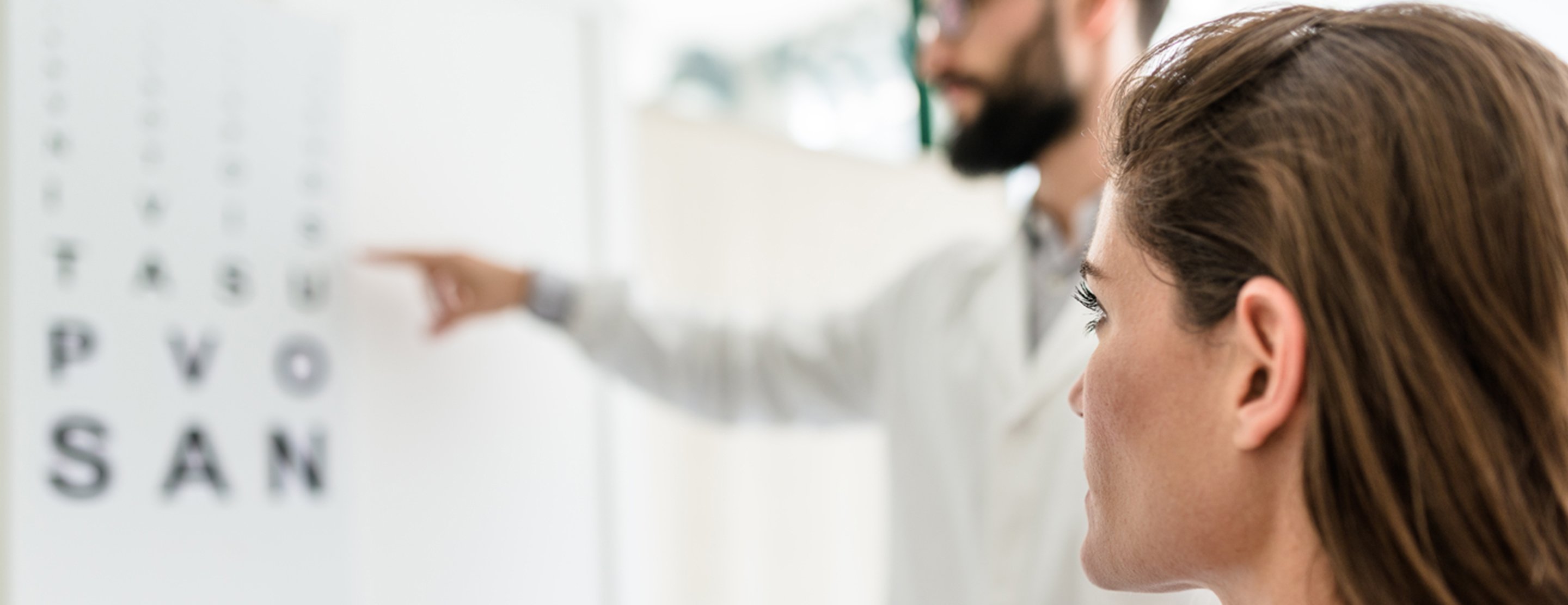
Visual acuity test
Definition
The visual acuity test is used to determine the smallest letters you can read on a standardized chart (Snellen chart) or a card held 20 feet (6 meters) away. Special charts are used when testing at distances shorter than 20 feet (6 meters). Some Snellen charts are actually video monitors showing letters or images.
Alternative Names
Eye test - acuity; Vision test - acuity; Snellen test
How the Test is Performed
This test may be done in a health care provider's office, a school, workplace, or elsewhere.
You will be asked to remove your glasses or contact lenses and stand or sit 20 feet (6 meters) from the eye chart. You will keep both eyes open.
You will be asked to cover one eye with the palm of your hand, a piece of paper, or a small paddle while you read out loud the smallest line of letters you can see on the chart. Numbers, lines, or pictures are used for people who cannot read, especially children.
If you are not sure of the letter, you may guess. This test is done on each eye, and one at a time. If needed, it is repeated while you wear your glasses or contacts. You may also be asked to read letters or numbers from a card held 14 inches (36 centimeters) from your face. This will test your near vision.
How to Prepare for the Test
No special preparation is necessary for this test.
How the Test will Feel
There is no discomfort.
Why the Test is Performed
The visual acuity test is a routine part of an eye examination or general physical examination, particularly if there is a
In children, the test is performed to screen for vision problems. Vision problems in young children can often be corrected or improved. Undetected or untreated problems may lead to permanent vision damage.
There are other ways to check vision in very young children, or in people who do not know their letters or numbers.
Normal Results
Visual acuity is expressed as a fraction.
- The top number refers to the distance you stand from the chart. This is often 20 feet (6 meters).
- The bottom number indicates the distance at which a person with normal eyesight could read the same line you correctly read.
For example, 20/20 is considered normal. 20/40 indicates that the line you correctly read at 20 feet (6 meters) away can be read by a person with normal vision from 40 feet (12 meters) away. Outside of the United States, the visual acuity is expressed as a decimal number. For example, 20/20 is 1.0, 20/40 is 0.5, 20/80 is 0.25, 20/100 is 0.2, and so on.
Even if you miss one or two letters on the smallest line you can read, you are still considered to have vision equal to that line.
What Abnormal Results Mean
Abnormal results may be a sign that you need glasses or contacts. Or it may mean that you have an eye condition that needs further evaluation by a provider.
Risks
There are no risks with this test.
References
Feder RS, Olsen TW, Prum BE Jr, et al. Comprehensive adult medical eye evaluation Preferred Practice Pattern guidelines. Ophthalmology. 2016;123(1):209-236. PMID: 26581558
Rubin GS. Visual acuity and contrast sensitivity. In: Schachat AP, Sadda SVR, Hinton DR, Wilkinson CP, Wiedemann P, eds. Ryan's Retina. 6th ed. Philadelphia, PA: Elsevier; 2018:chap 13.
Review Date: 02/28/2019
The information provided herein should not be used during any medical emergency or for the diagnosis or treatment of any medical condition. A licensed physician should be consulted for diagnosis and treatment of any and all medical conditions. Call 911 for all medical emergencies. Links to other sites are provided for information only -- they do not constitute endorsements of those other sites. Copyright ©2019 A.D.A.M., Inc., as modified by University of California San Francisco. Any duplication or distribution of the information contained herein is strictly prohibited.
Information developed by A.D.A.M., Inc. regarding tests and test results may not directly correspond with information provided by UCSF Health. Please discuss with your doctor any questions or concerns you may have.





